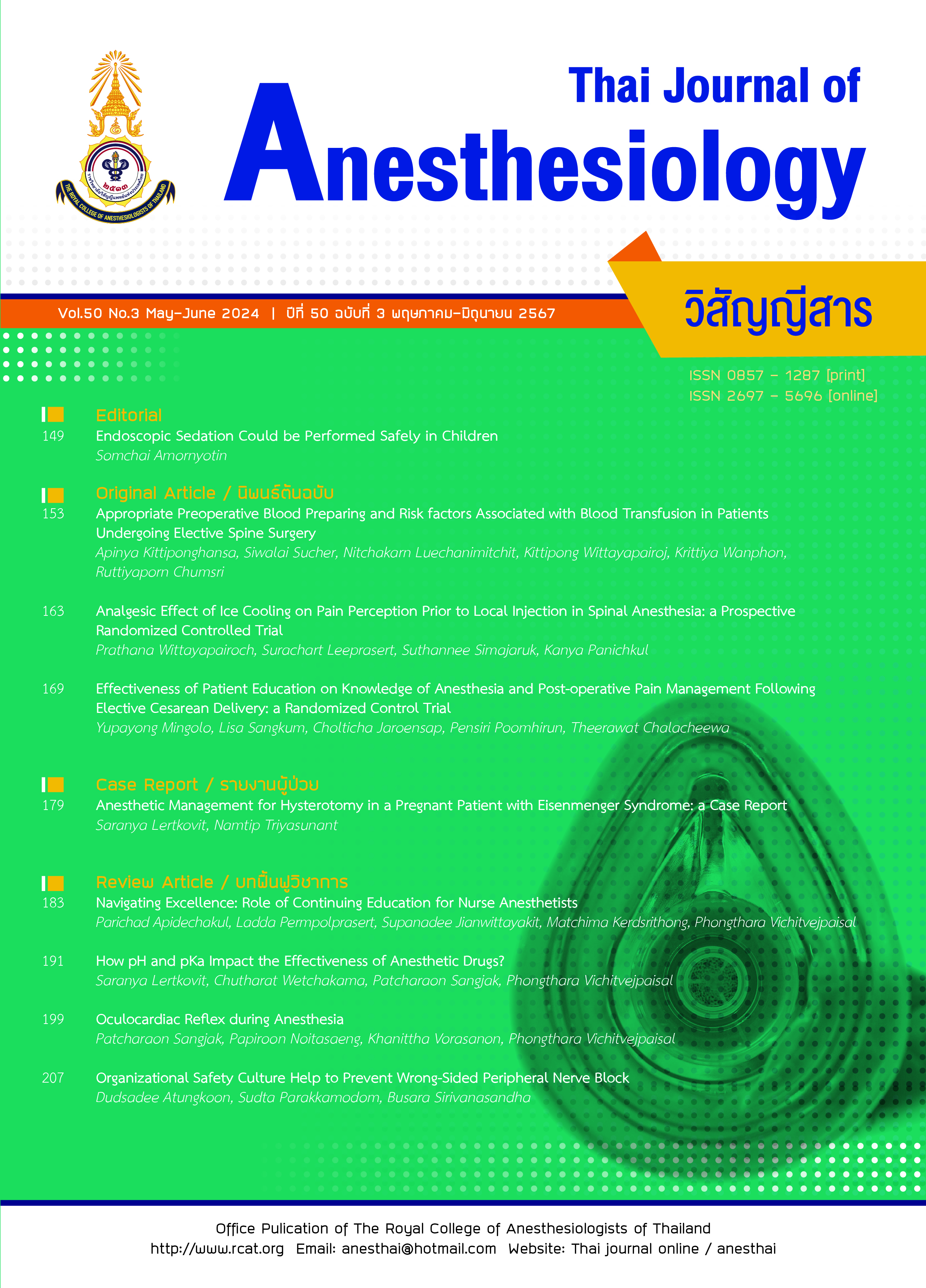พีเอชและพีเคเอมีผลต่อประสิทธิผลของยาระงับความรู้สึกอย่างไร
Main Article Content
บทคัดย่อ
โดยทั่วไปยามีฤทธิ์เป็นกรดหรือด่างอ่อน เมื่อถูกทำละลายจะได้สารละลายด่างหรือกรดตามลำดับ ค่าพีเคเอแสดงความเป็นกรดด่างเฉพาะของยาแต่ละตัว กำหนดความสามารถในการแตกตัว ได้อนุภาคที่มีประจุซึ่งละลายน้ำได้กับอนุภาคที่ไม่มีประจุซึ่งละลายในไขมัน กระบวนการนี้สามารถย้อนกลับหรือเปลี่ยนแปลงได้ตลอดเวลาภายใต้พีเอชและอุณหภูมิของสภาพแวดล้อมในขณะนั้น ตามสมการของเฮนเดอร์สัน-แฮสเซลบาล์ค เมื่อพีเอชมีค่าเท่ากับพีเคเอยาทุกชนิดจะแตกตัวได้อนุภาคที่มีและไม่มีประจุในปริมาณเท่ากัน ยาที่มีฤทธิ์เป็นกรดพีเอชจะแปรตามอนุภาคที่มีประจุและแปรผกผันกับอนุภาคที่ไม่มีประจุ ส่วนยาที่มีฤทธิ์เป็นด่างจะตรงข้ามกัน ยาระงับความรู้สึกส่วนใหญ่มีฤทธิ์เป็นด่างอ่อนอาทิ ยาชาเฉพาะที่ หรือยากลุ่มโอปิออยด์ เมื่อพีเอชเป็นกรด ยาจะแตกตัวได้อนุภาคไอออนที่ไม่มีประจุในปริมาณน้อย ทำให้ความสามารถในการซึมผ่านชั้นไขมันภายในชั้นเมมเบรนได้ช้ากว่าในภาวะที่พีเอชเป็นด่าง ซึ่งยาจะแตกตัวได้อนุภาคไอออนที่ไม่มีประจุในปริมาณที่ค่อนข้างมาก เมื่อต้องการใช้ยาชาเฉพาะที่เพื่อผ่าฝี ยาชาเฉพาะที่จะออกฤทธิ์น้อยลงเนื่องจากเนื้อเยื่อรอบฝีมีสภาพเป็นกรด จึงควรต้องปรับสภาพสารละลายในขวดยาให้ค่อนไปทางด่างด้วยสารละลายโซเดียมคาร์บอเนต หรือให้ผู้ป่วยรับประทานยาปฏิชีวนะล่วงหน้าก่อนทำหัตถการเพื่อปรับสภาพเนื้อเยื่อให้มีความเป็นกรดลดลง จะช่วยเพิ่มประสิทธิผลการออกฤทธิ์ของยาชาเฉพาะที่
Article Details

อนุญาตภายใต้เงื่อนไข Creative Commons Attribution-NonCommercial-NoDerivatives 4.0 International License.
เอกสารอ้างอิง
Shotelersuk V, Tongsima S, Pithukpakorn M, Eu-Ahsunthornwattana J, Mahasirimongkol S. Precision medicine in Thailand. Am J Med Genet C Semin Med Genet. 2019;181:245-53.
Urso R, Blardi P, Giorgi P. A short introduction to pharmacokinetics. Eur Rev Med Pharmacol Sci. 2002;6:33-44.
Becker DE, Reed KL. Local anesthetics: review of pharmacological considerations. Anesth Prog. 2012;59:90-102.
Michel-Levy JM. Pharmacokinetics and pharmacodynamics of local anesthetics. In: Whizar-Lugo VM, Hernández-Cortez E, eds. Topics in local anesthetics. Rijeka: IntechOpen; 2020. Available from: http://dx.doi.org/10.5772/intechopen.91700.
Giovannitti JA Jr, Rosenberg MB, Phero JC. Pharmacology of local anesthetics used in oral surgery. Oral Maxillofac Surg Clin North Am. 2013;25:453-65.
Taylor A, McLeod G. Basic pharmacology of local anaesthetics. BJA Educ. 2020;20:34-41.
Iqbal J, Hussain MM. Intestinal lipid absorption. Am J Physiol Endocrinol Metab. 2009;296:E1183-94.
Hills AG. pH and the Henderson-Hasselbalch equation. Am J Med. 1973;55:131-3.
Gilbert-Kawai ET, Wittenberg MD. Essential equations for anaesthesia key clinical concepts for the FRCA and EDA. Cambridge: Cambridge University Press. 2014.
Ferry RM. Lawrence Joseph Henderson. Science. 1942;95:316-8.
Warburg E. [Karl Albert HASSELBALCH, 1 November 1874-19 September 1962]. Ugeskr Laeger. 1962;124:1550.
Pope RLE, Brown AM. A primer on tissue pH and local anesthetic potency. Adv Physiol Educ. 2020;44:305-8.
Goodchild JH, Donaldson M. Comparing the pH change of local anesthetic solutions using two chairside buffering techniques. Compend Contin Educ Dent. 2016;37:e6-12.
Lambert DH. Clinical value of adding sodium bicarbonate to local anesthetics. Reg Anesth Pain Med. 2002;27:328-9.
Sinnott CJ, Garfield JM, Thalhammer JG, Strichartz GR. Addition of sodium bicarbonate to lidocaine decreases the duration of peripheral nerve block in the rat. Anesthesiology. 2000;93:1045-52.
Bucklin B, Santos A. Local anesthetics and opioids. In: Chestnut DH, ed. Chestnut’s obstetric anesthesia:
principles and practice. 6th ed. Philadelphia: Elsevier; 2020.


